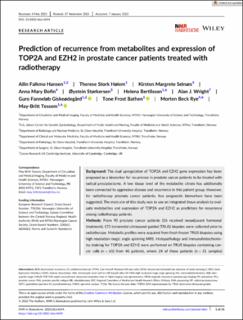| dc.description.abstract | Background
The dual upregulation of TOP2A and EZH2 gene expression has been proposed as a biomarker for recurrence in prostate cancer patients to be treated with radical prostatectomy. A low tissue level of the metabolite citrate has additionally been connected to aggressive disease and recurrence in this patient group. However, for radiotherapy prostate cancer patients, few prognostic biomarkers have been suggested. The main aim of this study was to use an integrated tissue analysis to evaluate metabolites and expression of TOP2A and EZH2 as predictors for recurrence among radiotherapy patients.
Methods
From 90 prostate cancer patients (56 received neoadjuvant hormonal treatment), 172 transrectal ultrasound-guided (TRUS) biopsies were collected prior to radiotherapy. Metabolic profiles were acquired from fresh frozen TRUS biopsies using high resolution-magic angle spinning MRS. Histopathology and immunohistochemistry staining for TOP2A and EZH2 were performed on TRUS biopsies containing cancer cells (n = 65) from 46 patients, where 24 of these patients (n = 31 samples) received hormonal treatment. Eleven radical prostatectomy cohorts of a total of 2059 patients were used for validation in a meta-analysis.
Results
Among radiotherapy patients with up to 11 years of follow-up, a low level of citrate was found to predict recurrence, p = 0.001 (C-index = 0.74). Citrate had a higher predictive ability compared with individual clinical variables, highlighting its strength as a potential biomarker for recurrence. The dual upregulation of TOP2A and EZH2 was suggested as a biomarker for recurrence, particularly for patients not receiving neoadjuvant hormonal treatment, p = 0.001 (C-index = 0.84). While citrate was a statistically significant biomarker independent of hormonal treatment status, the current study indicated a potential of glutamine, glutamate and choline as biomarkers for recurrence among patients receiving neoadjuvant hormonal treatment, and glucose among patients not receiving neoadjuvant hormonal treatment.
Conclusion
Using an integrated approach, our study shows the potential of citrate and the dual upregulation of TOP2A and EZH2 as biomarkers for recurrence among radiotherapy patients. | en_US |

